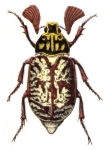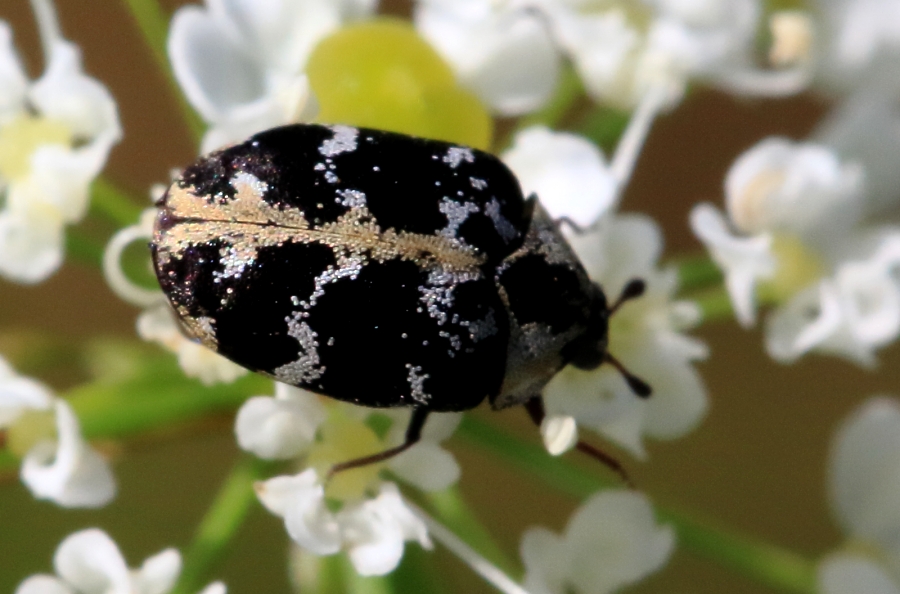|
Description / Habitats / Flora / Vertebrates / Insects / Invertebrates / What's that Bug? Home / Nestos Delta / Bibliography / About this site / Links / Contents / Galleries ____________________________________________________________________________ |
|
__________________________________________________________________________________________________________ THE CARPET BEETLES (COL., DERMESTIDAE) OF THÁSOS
Anthrenus scrophulariae (c) NobbiP (CC BY-SA 3.0) Also known as skin or larder beetles, the Dermestidae are essentially scavengers of dry organic material with many species developing as larvae on animal products (skin, fur, hair, leather, etc.) as they can digest keratin, whilst others feed on dry plant material such as nuts, seeds and cotton. They are also widely regarded as a pest in entomological collections as some species feed on dried insect remains. Both lifestyles have given rise to something of a bad reputation for the Dermestidae in general, particularly where they cause damage to stored food products or textiles. However, as with other scavengers, they play an important ecological role in breaking down organic matter and returning nutrients to the ecosystem, as well as performing a function as pollinators in the adult stage as many species feed on pollen as adults. They are generally quite small beetles, 3-4mm in length being typical of most Anthrenus spp. for instance, but some species may be 10-12 mm long. In general they are either of dark colouration or brightly patterned with coloured scales. Especially in warmer regions, the conspicuous presence of adult Anthrenus spp. on flowers is often the only sign of members of the Dermestidae, as many others spend their lives out of sight under bark, in ants' nests, in bird and animal corpses, within piles of dead vegetation, etc. Due to their ability to develop on food products and textiles they may also be encountered in human habitation (although nowadays rarely as pests because of the development of synthetic fabrics) and as such some species are cosmopolitan as they have been widely distributed through international trade. Karnozickij (1959) recorded three species of Dermestidae on Thásos in 1943, but I am not aware of any other records from the island. Háva (2018) lists records of Thorictus grandicollis from the northern Aegean islands of Samos, Lesbos and Lemnos but I have not come across any specific studies of the Aegean fauna. Nardi & Háva (2013) report a total of 95 species from Italy, but more comparable is the list of 19 species from the Maltese islands by Háva & Mifsud (2006). My incidental collecting of dermestids on Thásos has produced ten species (marked with an asterisk in the Checklist below) in addition to the three that Karnozickij (loc. cit.) found, giving a total of 13 species for the island. Anthrenus delicatus is probably the commonest species encountered, but all four of the recorded Anthrenus species are probably widespread amongst the flower-rich olive groves and coastal habitats of the lowlands. In the pine forests of the uplands Orphilus beali can be beaten in abundance from hawthorn blossom and pine branches. It should be noted that Orphilus niger (Rossi, 1790) may also be represented on the island. It is necessary to dissect specimens to separate O. beali and O. niger, external characters are unreliable, and both species occur in similar habitats in the Mediterranean region (Zhantiev 2001). So far all specimens that have been examined have proven to be O. beali. Several genera or species groups of the Dermestidae are considered to be in need of revision but Háva (2011) is a good starting point for the identification of European species. Although this is a key to Czech & Slovak Dermestidae it is bilingual and as such is the most comprehensive key available in English. Obviously it cannot be confidently relied upon for the Greek fauna, but a lot can be identified if used in conjunction with Háva (2004) and reviews at generic level, such as John & Andreae (1967) for Thorictus, Mroczkowski (1967) for Megatoma, Zhantiev (2001) for Orphilus, Kadej et al (2007) for taxa in the Anthrenus pimpinellae species group, etc. The extensive gallery maintained by Andreas Hermann at http://www.dermestidae.com/Abbildungen.html, with images of adult habitus as well as key characters in many instances, is also an invaluable source for checking the likelihood of an identification.
CHECKLIST
Anthrenus delicatus Kiesenwetter, 1851 *
Globicornis cf. picta (Küster, 1851) *
Notes: Andreas Hermann comments that Attagenus (sensu stricta) is in need of revision but the specimens from Thásos are probably A. persicus. Similarly, Globicornis (sensu stricta) also needs to be revised, but currently these specimens would be regarded as G. picta. Andreas is warmly thanked for his help with identification.
REFERENCES
Háva, J. 2004. World keys to the genera and subgenera of Dermestidae (Coleoptera), with descriptions, nomenclature and distributional records. Acta Musei Nationalis Pragae, Series B, Natural History, 60: 149–164. Háva, J. 2018. Contribution to the knowledge of Thorictus Germar, 1834 from Greece (Coleoptera: Dermestidae: Thorictinae). Folia Heyrovskyana, Series A, 26: 8-12 Háva, J. & Mifsud, D. 2006. The dermestid beetles (Coleoptera: Dermestidae) of the Maltese Archipelago (Central Mediterranean). Studies and reports of District Museum Prague-East Taxonomical Series, 2: 51-63. John, A. & Andreae, H. 1967. Revision der Gattung Thorictus Germar (Coleoptera, Thorictidae). III. Teil. Entomologische Abhandlungen und Berichte aus dem Staatlichen Museum für Tierkunde in Dresden, 34: 145–199. Kadej, M., Háva, J. & Kalík, V. 2007. Review of the Anthrenus pimpinellae species group from Palaearctic region (Coleoptera: Dermestidae: Anthrenini). Genus, 18: 721–750. Karnozickij, N. 1959. Materialien zur Koleopteren-Fauna der Agäischen Küste und Insel Thasos. Izv. zool. Inst. Sof., 8: 237-253. Mroczkowski, M. 1967. The Palearctic Species of Megatoma Herbst (Coleoptera, Dermestidae). Polskie Pismo Entomologiczne, Wroclaw, 37: 3–24. Nardi, G. & Háva, J. 2013. Italian Dermestidae: notes on some species and an updated checklist (Coleoptera). ZooKeys, 360: 45–81 Zhantiev, R.D. 2001. Palaearctic Dermestid Beetles of the Genus Orphilus Er. (Coleoptera, Dermestidae). Entomological Review, 81: 200–210.
|

















